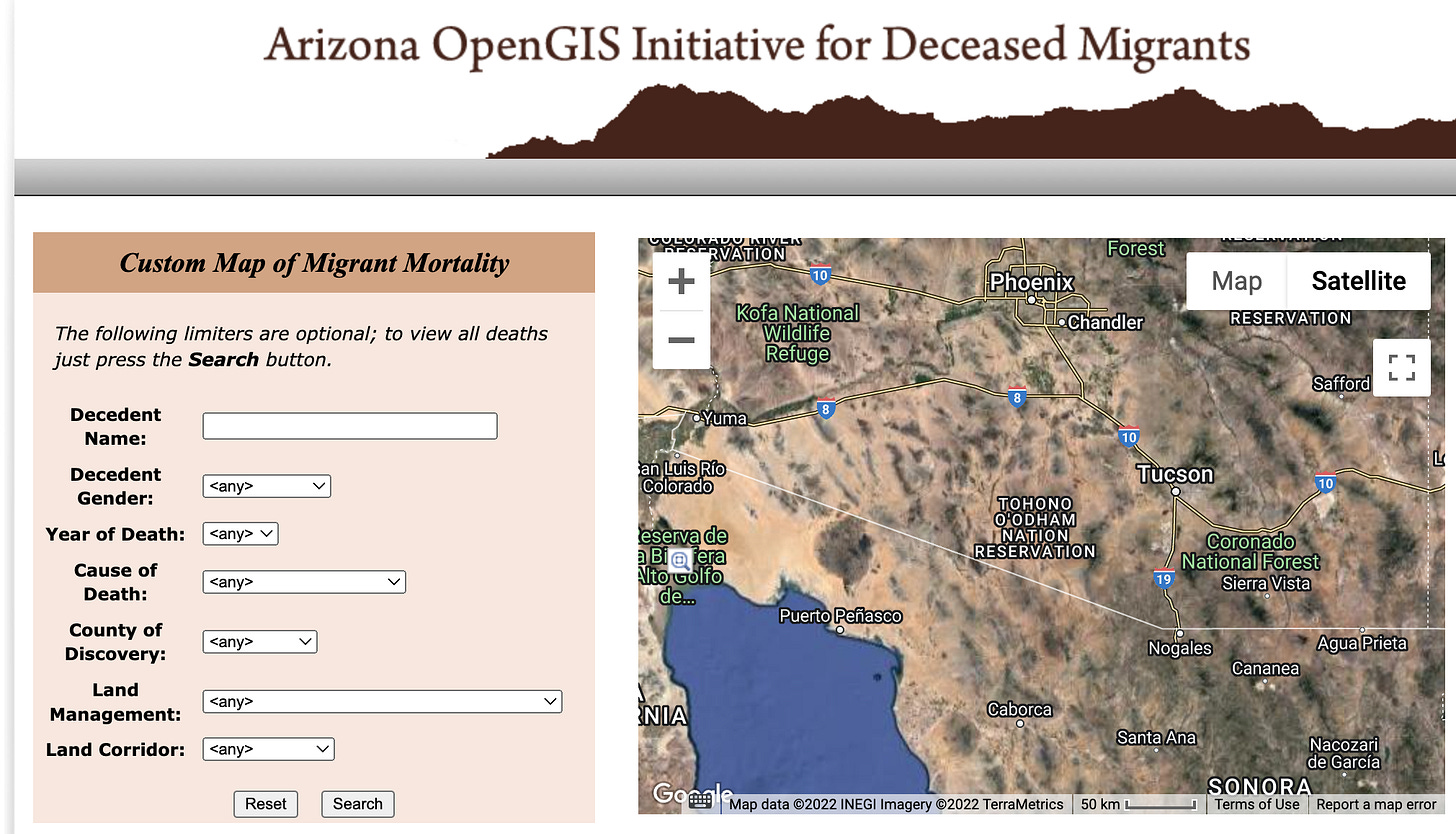Refugees Face Life in Prison for Driving Boat, Congress Warns White House about ICE's ATD Program, New Book about Border Patrol, and Much More
As we get closer to the midterm elections here in the United States, we can expect immigration discourse to heat up. This makes it more important than ever to have reliable, up-to-date, and nuanced sources of information about immigration.
As I told my students on the final day of class last week, immigration is a tough and potentially divisive topic—there’s no getting around it—but it is possible to think soberly and compassionately about immigration in a way that is grounded in reality.
If you question how important this is, just read this alarming report by the New York Times about “far-right activists who are intercepting migrant children and collecting information about their families, based on an unfounded conspiracy theory that they are falling prey to sex-trafficking rings.” How we think matters.
In this newsletter, I try to bring together a mix of journalism, academic research, law and policy news, original data, and first-hand experience to provide some insight into what’s happening in immigration today. My goal is to make this readable for a very general audience but interesting enough to be a valuable resource even for other immigration professionals. If you find this valuable, please leave a comment below (I always respond), share this newsletter with others, or at least share the resources in this newsletter with others. Thank you.
Here’s what you’ll find in today’s newsletter:
Federal Judges Run the Immigration System Now
Updates on ICE’s Immigrant Monitoring Program
Data Surveillance Following the End of Roe
Three Refugees Face Multiple Lifetime Sentences for Piloting Boat
New Book Exposes Border Patrol’s Dangerous Practices
Border Patrol Fails to Adequately Count Migrant Deaths
In Other News
Federal Judges Run the Immigration System Now
Federal judges are weighing in more than ever on immigration policies that are issued by the White House. When I think about just the past five years, I can think of many court battles, including fights over DACA (Deferred Action for Childhood Arrivals), Trump’s so-called Muslim Ban, the Migrant Protection Protocols (see my article on MPP here), and now Title 42. All of these court cases mean that federal judges are playing an increasingly influential role in immigration policy.
Jasmine Aguilera (@Jas_Aguilera) (easily one of my favorite immigration journalists) wrote a very good article last week on this phenomenon for TIME titled “Why Judges Are Basically in Charge of U.S. Immigration Policy Now.” The article explains that: “Because Congress has failed to act meaningfully since the 1990s to reform the U.S. immigration system, immigration policy has been increasingly shaped by court challenges.
Jasmine’s article also comes with great quotes from colleagues of mine at Cornell and the Bipartisan Policy Center.
“This is a manifestation of our broken immigration system. … Today, almost every executive action on immigration is being challenged in the courts.” —Stephen Yale-Loehr, professor of immigration law at Cornell University
This ad-hoc system has resulted, both at the U.S.-Mexico border and within government agencies, in “peak confusion.” … "That kind of back and forth is just terrible for any sort of consistency or continuity in any policy," Theresa Brown (@BPC_TBrown) of the Bipartisan Policy Center.
I think the takeaway of the article (and my experience) is: immigration has become more politicized by state governors than ever, which means everything is going to get litigated ad nauseam, and there’s no way around this unless or until Congress acts. Which it won’t. So this is the world we live in at the moment.
Updates on ICE’s Immigrant Monitoring Program
As you know if you’ve been following this newsletter, I’ve been really interested in the growth of alternatives to detention over the past few months. Sejal Zota (@sejalzota) from Just Futures Law was on the Lawfare Podcast this week to discuss the growth of ICE’s immigrant monitoring program.
A group of lawmakers including Congresswoman Rashida Tlaib sent a letter to Congress recently calling for greater oversight of ICE’s ATD program as well as a re-evaluation of the ICE’s $2.2 billion contract with BI, the private company that runs ICE’s monitoring program. See the Guardian article here and the original letter can be found here.
Data Surveillance Following the End of Roe
Immigrants aren’t the only ones that should be worried about electronic monitoring and surveillance. In an earlier post on ICE’s immigrant monitoring program, I emphasized that immigrants aren’t the only ones being tracked in the United States, and said that “the potential for smartphone surveillance and hacking by government or private actors has already proven to be a frightening reality.”
Now that the Supreme Court is planning to overturn Roe v. Wade, new fears are emerging that private companies, in partnership with law enforcement, could use geographic location data from smartphones (and other methodologies) to identify people attempting to have an abortion. Regardless of one’s views on abortion, the possibility of using smartphones’ geolocation features as well as search history and even menstruation calculators to identify women who would like to have, or who have had, an abortion is a frightening potential.
The podcast Recode Daily briefly describes how these technologies work in a new episode just released this morning in an interview with Lil Kalish (@lil_kalish).
If you want to learn more about abortion and data privacy, sign up for this upcoming workshop by the Aspen Institute on Wednesday (May 11) that will address these questions. The event description reads:
“With a recently-leaked Supreme Court majority decision draft signaling the long-suspected overturning of landmark reproductive rights case Roe v. Wade, abortion would likely be outlawed in a majority of states. By issuing warrants for search histories, combing through social media posts, and tapping location data to track movement, law enforcement will be able to exploit an ever-growing suite of unregulated digital forensic tools to find and prosecute people en masse.”
For further reading:
Data Broker Is Selling Location Data of People Who Visit Abortion Clinics
Location Data Firm Provides Heat Maps of Where Abortion Clinic Visitors Live
Meet Abortion Bans’ New Best Friend—Your Phone (by Lil Kalish from the Recode Daily podcast)
Three Refugees Face Multiple Lifetime Sentences for Piloting Boat
Borderline Europe reports that three Syrian refugees are currently facing a combined 18 life sentences because they steered a boat that became shipwrecked near the Greek island of Paros. Because much of the refugee migration to Europe comes through maritime migration routes, European counties—especially Italy—have attempted to restrict migration by criminalizing the act of navigating vessels as if the captains were traffickers. This case comes after another high-profile case last year involving a Somali migrant who received a 142-year sentence after taking the wheel of a smuggling boat in order to save himself and the passengers.
All of this comes at a time when the EU is more than doubling its funding for border enforcement and security agencies and increasing funding for the externalization of border controls.
New Book Exposes Border Patrol’s Dangerous Practices
My incredibly productive colleague, Reece Jones, a geographer at the University of Hawai‘i at Manoa (yes, you read that correctly… Hawai’i), is coming out with a new book shortly after releasing White Borders last year to sustained and well-earned praise. His new book is called “Nobody Is Protected: How the Border Patrol Became the Most Dangerous Police Force in the United States.” The book can be pre-ordered from Counterpoint Press.


In his thread about the book on Twitter, Jones says, “Nobody is Protected maps the Border Patrol's history from its bigoted Wild West beginnings through the legal precedents that have unleashed today's militarized force to conduct warrantless stops within one hundred miles of land borders or coastlines.”
Border Patrol Fails to Adequately Count Migrant Deaths
Reece’s book announcement comes during the same week that the Intercept’s Ryan Devereaux (@rdevro) published an article (“The Border Patrol is Systemically Failing to Count Migrant Deaths”) that describes Border Patrol’s failure to adequately count migrant deaths as the number of deaths appears to be increasing.
Devereaux cites a recently published GAO report titled “CBP Should Improve Data Collection, Reporting, and Evaluation for the Missing Migrant Program.“ The GAO report draws a comparison between Border Patrol’s official numbers and the numbers taken from the Arizona OpenGIS Initiative for Deceased Migrants. As you can see in the GAO’s graphic here, Border Patrol consistently undercounts migrant deaths when compared to the volunteer-driven of Arizona OpenGIS Initiative.
I had the good fortune to meet with one of the volunteers from the OpenGIS Initiative last year at the Border Forensics conference at Bard College. Their amazing team is showcasing the kinds of impactful work you can do with GIS, which we geographers would call “critical GIS” or “critical cartography.” If you’re looking for a book to get into critical GIS, I recommend Matt Wilson’s recent book “New Lines: Critical GIS and the Trouble of the Map.“
In Other News
In other news, USCIS announces that they will be “Simplifying, Improving Communication of Case Processing Data”, RollCall reports that some senators are restarting talks related to bipartisan immigration reform (forgive my extreme skepticism), and the AP reports that less immigrant labor is contributing to higher prices of consumer goods.
THANK YOU FOR READING! 🙏🏼
If you found this information useful, help more people see it by clicking the ☼LIKE☼ ☼SHARE☼ button below.










This substack is so informative and tinely. Thank you for keeping us informed!
Thank you for keeping us up to date and on our toes.